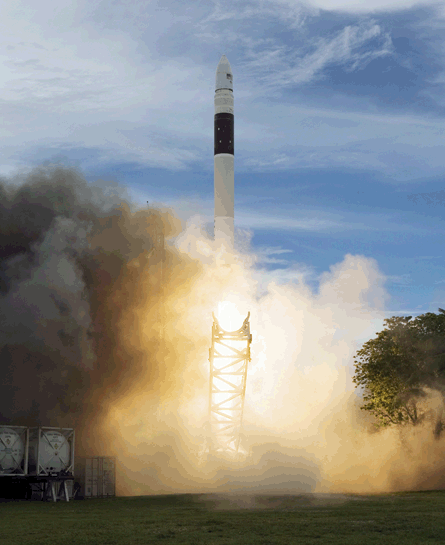The consecutive successes of Space Exploration Technologies' Falcon 1 rocket in September 2008 and on 15 July sets the seven-year-old company on a course for the fourth quarter maiden flight of its much larger Falcon 9 booster, which is scheduled to fly 23 times before 2016.
If successfully launched, the Falcon 9 - and its planned 30,000kg (66,000lb) to low Earth orbit heavy version -- will be competitive threats to international launch providers. SpaceX is offering $30 million launches when the worldwide market price is closer to $100 million, although SpaceX's competitors say that its prices are unsustainable.
 |
|---|
© Space Exploration TechnologiesThis July launch could be Falcon 1's last, to be replaced by the 1e |
SpaceX was founded by South Africa-born Paypal entrepreneur Elon Musk in 2002 to realise commercial human spaceflight. Its employees number more than 700, while Falcons 1 and 9 and the cargo and crew transporting Dragon spacecraft have been realised with a mix of funding from the US Department of Defense, NASA and private sources.
After the successful September 2008 test flight, the 15 July orbiting of Malaysia's Razaksat spacecraft was the fifth, and possibly last, Falcon 1 "Classic," as SpaceX refers to its first production flight design. While SpaceX has hinted at a possible sixth launch later this year, 2010 will see the maiden flight of the Falcon 1e that has double the Classic's payload capacity at 1,010kg to a 185km (114 miles) circular orbit.
But the Falcon 9 will be the main revenue generator. In December 2008 SpaceX won a $1.6 billion NASA contract to supply International Space Station cargo, with 12 launches until 2015, and has seven other commercial Falcon 9 launch orders, .
The first two Falcon 9 launches are planned for the fourth quarter of 2009. This is after a delay of a year, partly due to what Musk has called "the enormous amount of work to get done" for development and testing.
Qualification and acceptance testing has been completed on the maiden flight vehicle's first and second stages' engines and avionics suites. A full mission duration firing of the first stage, lasting 178s, took place in November 2008
As the Falcon 9 first stage uses nine of the Falcon 1 Classic's first-stage engine, the company will be more confident after two consecutive successes. However, the first three Classic launches failed because of a fuel valve leak, a second stage anomaly and a staging problem. Falcon 9 launches could also be undone by such events.
Flight two is the first demonstration launch of Falcon 9 and its Dragon spacecraft for NASA's Commercial Orbital Transportation Services (COTS) programme. Progress with the first Dragon, designed for worst-case scenario launch abort loads, includes structural and acoustic qualification. The first three 90lb-thrust (400N) Draco flight thrusters and their fuel tanks have been built.
This first COTS flight will see Dragon make several orbits before splashing down off California. SpaceX has 17 Dragon launches scheduled, 15 for NASA and two for its commercial Dragonlab service - an unmanned recoverable Dragon with science experiments.
SPACE X'S FAMILY OF VEHICLES |
| Falcon 1e | Falcon 9 | Dragon | |
| Length | 27.4m | 54.9m | 7m |
| Width | 1.7m | 3.6m | 3.6m |
| Mass | 44,958kg | 332,800kg | >6,000kg |
| Thrust on lift-off | 556kN | 5mN | N/A |
| Payload capacity | *1,010kg | **5,500kg with 7crew or 6,000kg cargo | N/A |
| Downmass | N/A | N/A | 3,000kg |
| Reaction control system | N/A | 4 | ***12-18 |
| Heatshield | N/A | N/A | Ablative |
|
The Falcon 9 flights, if successful, will come too late, however, to influence the Obama administration's review of US human spaceflight plans. Musk gave a presentation to the review's first public meeting on 17 June, which is to report by the end of August.
He wants Obama's administration to select a COTS-like option for US transport to LEO. SpaceX agreed to achieve NASA's COTS crew option, D, under its COTS agreement. SpaceX's Dragon programme manager Max Vozoff told the American Institute of Aeronautics and Astronautics' 18 June Innovations in Orbit conference that it will take an estimated 2.5 years to develop the launch abort system for a 2012 first test flight. SpaceX has also proposed that an unmanned Dragon is sent to the ISS as an escape vehicle.
Before SpaceX is paid to carry people, it is still focused on evolving its Falcon vehicles.Vozoff told the AIAA conference: "We have begun initial design of the Raptor [Falcon 9] upper stage." The block two Falcon 9 will deliver 5,500kg to geostationary transfer orbit.
Dragon evolutions envisaged by Vozoff include a robotic satellite rendezvous and inspection service with orbit boost or deorbit capabilities, which he says interests the Pentagon, and for the crewed version, SpaceX's raison d'être - commercial human orbital flight.
Source: Flight International


























